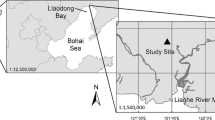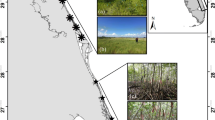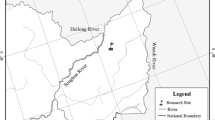Abstract
Understanding the link between ecosystem respiration (Reco) and its influential factors is necessary to evaluate the sources of gaseous carbon loss in coastal wetlands. Seablite (Suaeda salsa Pall.) is the main vegetation type pioneering temperate coastal wetlands in northeast China, and is generally an understudied wetland type. To evaluate the influence of environmental factors on Reco, a multi-year in-situ experiment was carried out during the growing seasons of 2012 to 2014. Total CO2 efflux was measured and separated further into soil microbial and belowground root respiration (Rs + r) and plant respiration (Rplant). Reco displayed strong seasonal variation, with effluxes as high as 845 to 1150 mg CO2 m−2 h−1 during summer months and as low as 32 to 111 mg CO2 m−2 h−1 during spring (when new shoots are sprouting) and fall (when plants are senescing) months. Aboveground plant structures contributed on average 79% to total plant biomass, and accounted for most of the Reco measured; i.e., 62–96% was associated as Rplant. Plant activity was strongly seasonal, accordingly driving Reco, with 1 g of soil-emergent S. salsa biomass (dry weight) producing approximately 1.58 mg CO2 per hour toward Reco during mid-summer. When water level was below the soil surface, Rs + r was exponentially correlated to air temperature. Because Reco for S. salsa marsh in the Liaohe Delta is controlled by plant growth cycles, inundation regime, and air temperature, this finding may be applied for national carbon budget estimation purposes from S. salsa wetlands throughout Northeast China and potentially close a key gap in understanding the role of this large wetland area in contributing to respiratory CO2 emissions globally.










Similar content being viewed by others
References
Arora B, Spycher NF, Steefel CI, Molins S, Bill M, Conrad ME, Dong W, Faybishenko B, Tokunaga TK, Wan J (2016) Influence of hydrological, biogeochemical and temperature transients on subsurface carbon fluxes in a flood plain environment. Biogeochemistry 127(2):1–30
Aubinet M, Vesala T, Papale D (2012) Eddy covariance: a practical guide to measurement and data analysis. Springer:365–376
Bäckstrand K, Crill PM, Jackowicz-Korczyñski M, Mastepanov M, Christensen TR, Bastviken D (2010) Annual carbon gas budget for a subarctic peatland, northern Sweden. Biogeosciences 7(1):95–108
Berglund Ö, Berglund K (2011) Influence of water table level and soil properties on emissions of greenhouse gases from cultivated peat soil. Soil Biology and Biochemistry 43(5):923–931
Brix H, Sorrell BK, Schierup H-H (1996) Gas fluxes achieved by in situ convective flow in Phragmites australis. Aquatic Botany 54(2):151–163
Brix H, Ye S, Laws EA, Sun D, Li G, Ding X, Yuan H, Zhao G, Wang J, Pei S (2014) Large-scale management of common reed, Phragmites australis , for paper production: A case study from the Liaohe Delta, China. Ecological Engineering 73:760–769
Cannell M, Smith R (1983) Thermal time, chill days and prediction of budburst in Picea sitchensis. Journal of Applied Ecology 20(3):951–963
Chen L, Liu ZT, Han GX, Chu XJ, Sun BY, Liu HF, Li JW (2016) Effects of environmental and biotic factors on soil respiration in a coastal wetland in the Yellow River Delta, China. Chinese Journal of Applied Ecology 27(6):1795–1803
Chmura GL, Anisfeld SC, Cahoon DR, Lynch JC (2003) Global carbon sequestration in tidal, saline wetland soils. Global Biogeochemical Cycles 17(4):1111–1132
Cox PM, Betts RA, Jones CD, Spall SA, Totterdell IJ (2000) Acceleration of global warming due to carbon-cycle feedbacks in a coupled climate model. Nature 408(6809):184–187
Cui B, He Q, Zhao X (2008) Ecological thresholds of Suaeda salsa to the environmental gradients of water table depth and soil salinity. Acta Ecologica Sinica 28(4):1408–1418
Davidson EA, Janssens IA (2006) Temperature sensitivity of soil carbon decomposition and feedbacks to climate change. Nature 440(7081):165–173
Devol AH, Richey JE, Forsberg BR, Martinelli LA (1990) Seasonal dynamics in methane emissions from the Amazon River floodplain to the troposphere. Journal of Geophysical Research Atmospheres 95(D10):16417–16426
Ding Y, Ye S, Zhao Q (2012) Nutrients and carbon sequestration in the newly created wetlands of the Yellow River Delta. Geological review 58(1):183–189
Dyukarev EA (2017) Partitioning of net ecosystem exchange using chamber measurements data from bare soil and vegetated sites. Agricultural and Forest Meteorology 239:236–248
Flanagan LB, Wever LA, Carlson PJ (2002) Seasonal and interannual variation in carbon dioxide exchange and carbon balance in a northern temperate grassland. Global Change Biology 8(7):599–615
Giltrap DL, Li C, Saggar S (2010) DNDC: a process-based model of greenhouse gas fluxes from agricultural soils. Agriculture, Ecosystems & Environment 136(3–4):292–300
Guan B, Yu J, Wang X, Fu Y, Kan X, Lin Q, Han G, † ZL (2011) Physiological responses of halophyte Suaeda salsa to water table and salt stresses in coastal wetland of Yellow River Delta. CLEAN – Soil Air Water 39(12):1029–1035
Hall S, Hopkins DW (2015) A microbial biomass and respiration of soil, peat and decomposing plant litter in a raised mire. Plant Soil and Environment 61(9):405–409
Han G, Zhou G, Xu Z, Yang Y, Liu J, Shi K (2007) Soil temperature and biotic factors drive the seasonal variation of soil respiration in a maize ( Zea mays L.) agricultural ecosystem. Plant and Soil 291(1–2):15–26
Han G, Luo Y, Li D, Xia J, Xing Q, Yu J (2014) Ecosystem photosynthesis regulates soil respiration on a diurnal scale with a short-term time lag in a coastal wetland. Soil Biology and Biochemistry 68(1):85–94
Hassink J (1992) Effects of soil texture and structure on carbon and nitrogen mineralization in grassland soils. Biology and Fertility of Soils 14(2):126–134
Holm GO, Perez BC, Mcwhorter DE, Krauss KW, Johnson DJ, Raynie RC, Killebrew CJ (2016) Ecosystem level methane fluxes from tidal freshwater and brackish marshes of the Mississippi River Delta: implications for coastal wetland carbon projects. Wetlands 36(3):401–413
Jankowski KL, Törnqvist TE, Fernandes AM (2017) Vulnerability of Louisiana's coastal wetlands to present-day rates of relative sea-level rise. Nature Communications 8:14792
Ji Y, Zhou G, New T (2009) Abiotic factors influencing the distribution of vegetation in coastal estuary of the Liaohe Delta, Northeast China. Estuaries and Coasts 32(5):937–942
Johnson LC, Shaver GR, Cades DH, Rastetter E, Nadelhoffer K, Giblin A, Laundre J, Stanley A (2000) Plant carbon-nutrient interactions control CO2 exchange in Alaskan wet sedge tundra ecosystems. Ecology 81(2):453–469
Juszczak, Radoslaw, Michalak-Galczewska, Maria, Humphreys, Elyn, Olejnik, Janusz, Acosta (2013) Ecosystem respiration in a heterogeneous temperate peatland and its;sensitivity to peat temperature and water table depth. Plant and Soil 366(1–2):505–520
Kandel TP, Elsgaard L, Lærke PE (2013) Measurement and modelling of CO2 flux from a drained fen peatland cultivated with reed canary grass and spring barley. Global Change Biology Bioenergy 5(5):548–561
Krauss KW, Whitbeck JL, Howard RJ (2012) On the relative roles of hydrology, salinity, temperature, and root productivity in controlling soil respiration from coastal swamps (freshwater). Plant and Soil 358(1–2):265–274
Lafleur PM, Moore TR, Roulet NT, Frolking S (2005) Ecosystem respiration in a cool temperate bog depends on peat temperature but not water table. Ecosystems 8(6):619–629
Larocque GR, Bhatti JS, Gordon AM, Luckai N, Wattenbach M, Liu J, Peng C, Arp PA, Liu S, Zhang CF (2008) Uncertainty and Sensitivity Issues in Process-based Models of Carbon and Nitrogen Cycles in Terrestrial Ecosystems. Developments in Integrated Environmental Assessment 3
Li X, Fu H, Guo D, Li X, Wan C (2010) Partitioning soil respiration and assessing the carbon balance in a Setaria italica (L.) Beauv. Cropland on the loess plateau, northern China. Soil Biology and Biochemistry 42(2):337–346
Lu W, Xiao J, Liu F, Zhang Y, Liu CA, Lin G (2016) Contrasting ecosystem CO2 fluxes of inland and coastal wetlands: a meta-analysis of eddy covariance data. Global Change Biology 23(3):1180–1198
Luo H, Huang F, Zhang Y (2003) Space-time change of marsh wetland in Liaohe delta area and its ecological effect. Journal of Northeast Normal University 35(2):100–105
Mao P, Chen W, Liu Y, Wang G, Chen J, Han G, Zhang Z, Yu J (2011) Biomass allocation in Suaeda salsa population in different habitats of coastal zone. Ecology and Environmental Sciences 20:1214–1220
Marínmuñiz JL, Hernández ME, Morenocasasola P (2015) Greenhouse gas emissions from coastal freshwater wetlands in Veracruz Mexico: effect of plant community and seasonal dynamics. Atmospheric Environment 107(3):107–117
Melillo JM, Steudler PA, Aber JD, Newkirk K, Lux H, Bowles FP, Catricala C, Magill A, Ahrens T, Morrisseau S (2002) Soil warming and carbon-cycle feedbacks to the climate system. Science 298(5601):2173–2176
Metzger C, Jansson P-E, Lohila A, Aurela M, Eickenscheidt T, Belelli-Marchesini L, Dinsmore K, Drewer J, van Huissteden J, Drösler M (2015) CO2 fluxes and ecosystem dynamics at five European treeless peatlands–merging data and process oriented modeling. Biogeosciences 12(1):125–146
Mitsch WJ, Tejada J, Nahlik A, Kohlmann B, Bernal B, Hernández CE (2008) Tropical wetlands for climate change research, water quality management and conservation education on a university campus in Costa Rica. Ecological Engineering 34(4):276–288
Moore T, Dalva M (1993) The influence of temperature and water table position on carbon dioxide and methane emissions from laboratory columns of peatland soils. Journal of Soil Science 44(4):651–664
Mori S, Akiya M, Yamamura K, Murano H, Arao T, Kawasaki A, Higuchi K, Maeda Y, Yoshiba M, Tadano T (2010) Physiological role of sodium in the growth of the halophyte Suaeda salsa (L.) pall. Under high-sodium conditions. Crop Science 50(6):2492
Mukhopadhyay S, Maiti SK (2014) Soil CO2 flux in grassland, afforested land and reclamine overburden dumps: a case study. Land Degradation and Development 25(3):216–227
Neubauer SC, Franklin RB, Berrier DJ (2013) Saltwater intrusion into tidal freshwater marshes alters the biogeochemical processing of organic carbon. Biogeosciences 10(12):8171–8183
Nicholls RJ (2004) Coastal flooding and wetland loss in the 21st century: changes under the SRES climate and socio-economic scenarios. Global Environmental Change 14(1):69–86
Nicolini G, Aubinet M, Feigenwinter C, Heinesch B, Lindroth A, Mamadou O, Moderow U, Mölder M, Montagnani L, Rebmann C, Papale D (2018) Impact of CO2 storage flux sampling uncertainty on net ecosystem exchange measured by eddy covariance. Agricultural and Forest Meteorology 248:228–239
Olsson L, Ye S, Yu X, Wei M, Krauss KW, Brix H (2015) Factors influencing CO2 and CH4 emissions from coastal wetlands in the Liaohe Delta, Northeast China. Biogeosciences 12(16):4965–4977
Pugh CA, Reed DE, Desai AR, Sulman BN (2018) Wetland flux controls: how does interacting water table levels and temperature influence carbon dioxide and methane fluxes in northern Wisconsin? Biogeochemistry 137(1–2):15–25
Pumpanen J, Kolari P, Ilvesniemi H, Minkkinen K, Vesala T, Niinistö S, Lohila A, Larmola T, Morero M, Pihlatie M (2004) Comparison of different chamber techniques for measuring soil CO2 efflux. Agricultural and Forest Meteorology 123(3):159–176
Raich JW, Potter CS, Bhagawati D (2010) Interannual variability in global soil respiration, 1980-94. Global Change Biology 8(8):800–812
Reth S, Reichstein M, Falge E (2005) The effect of soil water content, soil temperature, soil pH-value and the root mass on soil CO2 efflux – a modified model. Plant and Soil 268(1):21–33
Rodríguez JF, Saco PM, Sandi S, Saintilan N, Riccardi G (2017) Potential increase in coastal wetland vulnerability to sea-level rise suggested by considering hydrodynamic attenuation effects. Nature Communications 8:16094
Sánchez-Cañete EP, Scott RL, van Haren J, Barron-Gafford GA (2017) Improving the accuracy of the gradient method for determining soil carbon dioxide efflux. Journal of Geophysical Research: Biogeosciences 122(1):50–64
Smith C, DeLaune R, Patrick W Jr (1983) Carbon dioxide emission and carbon accumulation in coastal wetlands. Estuarine, Coastal and Shelf Science 17(1):21–29
Song C, Xu X, Tian H, Wang Y (2009) Ecosystem–atmosphere exchange of CH4 and N2O and ecosystem respiration in wetlands in the Sanjiang plain, northeastern China. Global Change Biology 59(3):692–705
St-Hilaire F, Wu J, Roulet NT, Frolking S, Lafleur PM, Humphreys ER, Arora V (2010) McGill wetland model: evaluation of a peatland carbon simulator developed for global assessments. Biogeosciences 7(11):3517–3530
Verhulst, Pierre-François (1838) Notice sur la loi que la population poursuit dans son accroissement. Correspondance Mathématique et Physique (10):113–121
Wang G, Chen S (2012) A review on parameterization and uncertainty in modeling greenhouse gas emissions from soil. Geoderma 170:206–216
Wang GD, Wang M, Lu XG, Jiang M (2016) Surface elevation change and susceptibility of coastal wetlands to sea level rise in Liaohe Delta, China. Estuarine, Coastal and Shelf Science 180:204–211
Wanninkhof R, Knox M (2003) Chemical enhancement of CO2 exchange in natural waters. Limnology and Oceanography 41(4):689–697
World Meteorological Organization (2013) WMO Statement on the status of the global climate in 2013
World Meteorological Organization (2014) WMO Statement on the status of the global climate in 2014
Wu J, Guan K, Hayek M, Restrepo-Coupe N, Wiedemann KT, Xu X, Wehr R, Christoffersen BO, Miao G, Silva RD (2017) Partitioning controls on Amazon forest photosynthesis between environmental and biotic factors at hourly to interannual timescales. Global Change Biology 23(3):1240–1257
Xie X, Zhang MQ, Zhao B, Guo HQ (2014) Dependence of coastal wetland ecosystem respiration on temperature and tides: a temporal perspective. Biogeosciences 11(3):539–545
Xu X, Zou X, Cao L, Zhamangulova N, Zhao Y, Tang D, Liu D (2014) Seasonal and spatial dynamics of greenhouse gas emissions under various vegetation covers in a coastal saline wetland in Southeast China. Ecological Engineering 73:469–477
Yang G, Chen H, Wu N, Tian J, Peng C, Zhu Q, Zhu D, He Y, Zheng Q, Zhang C (2014) Effects of soil warming, rainfall reduction and water table level on CH4 emissions from the Zoige peatland in China. Soil Biology and Biochemistry 78(0):83–89
Ye S, Krauss KW, Brix H, Wei M, Olsson L, Yu X, Ma X, Wang J, Yuan H, Zhao G (2016) Inter-annual variability of area-scaled gaseous carbon emissions from wetland soils in the Liaohe Delta, China. PLoS One 11(8):e0160612
Yuste JC, Janssens IA, Ceulemans R (2005) Calibration and validation of an empirical approach to model soil CO2 efflux in a deciduous forest. Biogeochemistry 73(1):209–230
Zhang Q, Sun R, Jiang G, Xu Z, Liu S (2016) Carbon and energy flux from a Phragmites australis wetland in Zhangye oasis-desert area, China. Agricultural and Forest Meteorology 230–231:45–57
Acknowledgements
This study was jointly funded by the National Key R&D Program of China (2016YFE0109600), Ministry of Land and Resources program: “Special foundation for scientific research on public causes” (Grant No. 201111023), National Natural Science Foundation of China (Grant Nos. 41240022 & 40872167), China Geological Survey (Grant Nos. DD20189503, GZH201200503 and DD20160144), and in-kind contributions from the U.S. Geological Survey (through Project Annex No. 6, CH-02.0600) Land Carbon Program and Environments Program. Funding for L. Olsson was provided by Sino-Danish Center for Education and Research and the Danish Council for Independent Research – Natural Sciences (Project 4002-00333B) via a grant to HB. Any use of trade, firm, or product names is for descriptive purposes only and does not imply endorsement of the U.S. Government.
We thank Guangming Zhao, Hongming Yuan, Jin Wang, Xigui Ding, Xiongyi Miao, Jin Liu and other staff of our working group for field and laboratory assistance. We also thank the staff of Reed Institute of Panjin City for the help and convenience they offered. We thank Edward A. Laws from Louisiana State University for assistance with data analysis. Finally, we thank Olivier Pringault, Scott F. Jones, and an anonymous reviewer for the suggestions to improve our manuscript.
Author information
Authors and Affiliations
Corresponding author
Additional information
Publisher’s Note
Springer Nature remains neutral with regard to jurisdictional claims in published maps and institutional affiliations.
Electronic supplementary material
ESM 1
(DOCX 802 kb)
Rights and permissions
About this article
Cite this article
Yu, X., Ye, S., Olsson, L. et al. A 3-Year In-Situ Measurement of CO2 Efflux in Coastal Wetlands: Understanding Carbon Loss through Ecosystem Respiration and its Partitioning. Wetlands 40, 551–562 (2020). https://doi.org/10.1007/s13157-019-01197-0
Received:
Accepted:
Published:
Issue Date:
DOI: https://doi.org/10.1007/s13157-019-01197-0




